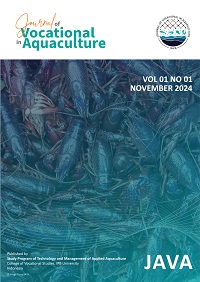Submissions
Author Guidelines
Preparing Your Paper
For full instructions, please download the file at this LINK
Author Statement Form can be downloaded HERE
The article's template can be downloaded HERE for English
Structure
Your paper should be compiled in the following order: title, name of the author(s) and their institutions, abstract; keywords; main text introduction, materials and methods, results, discussion; acknowledgments; declaration of interest statement; references; appendices (as appropriate); table(s) with caption(s) (on individual pages); figures; figure captions (as a list).
- Title must be brief, clear, specific, and informative which reflects the article content. The length of the title maximum 15 words. Each word of the title should be started with capitalized letter.
- Name of author(s) are written as references.
- Name of institution(s) where the research was conducted must be accompanied with the full address including institution/department, city, and country, and e-mail.
- Abstract must be written in English, in a single paragraph and no more than 250 words. Abstracts contain a clear statement of introduction, objective, methods, results/significance of the finding, and conclusion, with no references cited.
- Keywords should be written in no more than 5 (five) words or phrases.
- Introduction describes a brief background of the research, state of the arts, novelty, and objective(s). It should be written efficiently and supported by references and no more than 2 pages. Extensive discussion of relevant literature should be included in the discussion, not in the introduction.
- Materials and Methods
- It should be written clearly and completely containing a clear description of biological, analytical, and statistical procedures; so they can be repeated by other researchers. References of original methods/procedures must be stated and all modifications of procedures (if any) should be explained. Diets and animal conditions (breed, sex, age, body weight, and weighing conditions [i.e., with or without restriction of feed and (or) water]) also should be described clearly and fully.
- Authors should ensure that studies involving animals are performed according to animal ethics and welfare. All experimental animals should be cared for and used in compliance with international, national or local regulations. The authors are obliged to state explicitly in the method and attach a letter containing the name of the ethics authority and the approval number that experiments were approved by an authority concerning compliance with animal ethics and welfare.
- Authors should state clearly information of commercial product and equipment used in the research, such as commercial name, product/equipment spesification, and country.
- Appropriate statistical methods should be used, although the biological mechanism should be emphasized. The statistical model, classes, blocks, and experimental unit must be designated. Consultation with a statistician is recommended to prevent any incorrect or inadequate statistical methods.
- Results
- Data should be presented in Tables or Figures when feasible. There should be no duplication of data in Tables and Figures. Sufficient and comprehensive data followed with some index of variation (SEM pool) and significance level (e.g., p<0.01) should be presented to give a complete information and allow the reader to interpret the results of the experiment.
- The text should explain or elaborate the tabular data, but numbers should not be repeated extensively within the text.
- Discussion should be consistent and should interpret the results clearly and concisely, address biological mechanism and their significance, supported with suitable literature. The discussion should show relevance between the results and the field of investigation and/ or hypotheses. Results that are already described in the RESULTS section should not be repeated in the DISCUSSION section.
- Conclusion should be written briefly in a single paragraph but reflects the experimental results obtained. Conclusion should answer the objective of the research. Implication of results should be added stating what the findings of this research imply for animal production and (or) biology.
- Conflict of Interest should be stated clearly in the manuscript. Authors should clarify that there is no conflict of interest with any financial, personal, or other relationships with other people or organizations related to the material discussed in the manuscript.
- Acknowledgement (if any) to person(s) or institution(s) who help the experiment should be stated. Authors should also state the name and the number of the project.
- References:
- Please ensure that every reference cited in the text is also present in the reference list (and vice versa). We suggest authors use reference manager applications, such as EndNote, Mendeley, etc., to prepare citations and the list of references.
- References should be the last 10 year publication, with minimum 80% of journal.
- Citing a citation, such as Morris in Miftah et al. (2008), and using ‘Anonym’ as reference are not allowed.
- Authors should not use proceeding, thesis, and dissertation as references.
- The electronic publications are only allowed to use, if those are published by a competent source, such as journal and government or private institution. The accessed date should be put after the last sentence, except for journal.
- Reference citations in the text: Takahashi (2014) or (Takahashi, 2014); O’neil et al. (2006) or (O’neil et al., 1974); Priyanto & Johnson (2011) or (Priyanto & Johnson, 2011).
- References should be listed alphabetically by the author(s) last name(s) and the year of publication. If a reference has a digital object identifier (DOI), it should be written. For journals, author(s), year, title of the article(s), journal name, volume and number of publication, and pages. Journals should be abbreviated according to the conventional abbreviation used by Pubmed (http://www.ncbi.nlm.nih.gov/nlmcatalog/journals). For books, the order is all author(s), year, title of the book, name and place of publisher. For book chapter: author(s), year, title of the article, editor(s), book title, name and place of publisher.
- Some examples of references are presented below:
Journal
Samadi, S., S. Wajizah, & A. Munawar. 2018. Rapid and simultaneous determination of feed nutritive values by means of near infrared spectroscopy. Trop. Anim. Sci. J. 41:121-27. https://doi.org/10.5398/tasj.2018.41.2.121.
Kim, E. S., T. S. Sonstegard, C. P. Van Tassell, G. Wiggans, & M. F. Rothschild. 2015. The relationship between runs of homozygosity and inbreeding in Jersey cattle under selection. PLoS ONE 10: e0129967. https://doi.org/10.1371/journal.pone.0129967
Marbacher, S., K. Elisabeth, L. Schwyzer, I. Fischer, E. Nevzati, M. Diepers, U. Roelcke, A. R. Fathi, D. Coluccia, & J. Fandino. 2014. Use of fluorescence to guide resection or biopsy of primary brain tumors and brain metastases. Neurosurgical Focus FOC 36: E10. https://doi.org/10.3171/2013.12.FOCUS13464.
Books and Book Chapters
Latimer, G. W. Jr. 2019. Official Methods of Analysis of AOAC International. 21st ed. AOAC International; Maryland.
National Academies of Sciences, Engineering, and Medicine. 2016. Nutrient Requirements of Beef Cattle: 8th Rev. Ed. The National Academies Press, Washington, DC. https://doi.org/10.17226/19014.
Field, T. G. & R. E. Taylor. 2015. Scientific Farm Animal Production: An Introduction to Animal Science. 11th ed. Pearson Prentice Hall, Upper Saddle River, NJ.
Roux, S. J. & G. Clark. 2019. Extracellular ATP Signaling in Animals and Plants: Comparison and Contrast. In: S. Sopory. (Ed.). Sensory Biology of Plants. Springer, Singapore. https://doi.org/10.1007/978-981-13-8922-1_15
Electronic Publications
Kim, E. S., T. S. Sonstegard, C. P. Van Tassell, G. Wiggans, & M. F. Rothschild. 2015. The relationship between runs of homozygosity and inbreeding in Jersey cattle under selection. PLoS ONE 10: e0129967. https://doi.org/10.1371/journal.pone.0129967
IUCN. 2012. IUCN Red List Categories and Criteria: Version 3.1. 2nd Ed. IUCN, Gland and Cambridge. https://portals.iucn.org/library/sites/library/files/documents/RL-2001-001-2nd.pdf [December 22, 2021].
Aviagen. 2018. Ross Broiler Management Handbook. http://eu.aviagen.com/assets/Tech_Center/Ross_Broiler/Ross-BroilerHandbook2018-EN.pdf [December 22, 2021].
Submission Preparation Checklist
All submissions must meet the following requirements.
- The submission has not been previously published, nor is it before another journal for consideration (or an explanation has been provided in Comments to the Editor).
- Manuscripts are written in English or Bahasa Indonesia and use standard scientific usage.
- Manuscripts should be prepared in Microsoft Word format, except for Graphs using Microsoft Excel program and Figures using JPEG or PDF format.
- Manuscripts should be typed using Times New Roman fonts at 12 points.
- Manuscripts should be typed double spaced except for Title, Tables, Title of Graphs/Figures, and appendix typed single spaced. Manuscripts are prepared in A4 paper, margins on all four sides are 3 cm, and total number of pages is 10-20.
- Tables, Graphs, and Figures should be placed after the References of the manuscript.
- Use page numbers and line numbers.
Privacy Statement
The names and email addresses entered in this journal site will be used exclusively for the stated purposes of this journal and will not be made available for any other purpose or to any other party.











